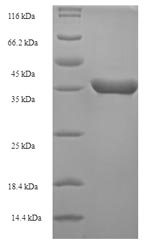The preparation of this recombinant E.coli def protein was to use gene recombination DNA technology to obtain a recombinant vector connected with a def fragment (2-169aa) that could be translated into the def protein and then transferred it into E.coli cells to express the recombinant def protein molecule. In order to get the target protein with high purity, N-terminal 6xHis-SUMO tag was used in the production. The purity is 90% determined by SDS-PAGE.
Peptide deformylase catalyzes the hydrolytic removal of the N-terminal formyl group from nascent proteins. This is an essential step in bacterial protein synthesis, making PDF an attractive target for antibacterial drug development. Peptide deformylase activity was first reported by Adams in 1968. However, further attempts to purify the enzyme from cell lysates failed because the activity was not stable. The enzyme was not characterized further until the early 1990s, when the deformylase gene, def, was cloned and peptide deformylase was subsequently overexpressed in Escherichia coli. Bacterial peptide deformylase belongs to a new class of metallohydrolases that utilize an Fe2+ ion as the catalytic metal ion. The ferrous ion in peptide deformylase is very unstable and can be quickly and irreversibly oxidized to the ferric ion, resulting in an inactive enzyme.






